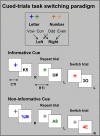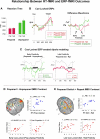Advance preparation in task-switching: converging evidence from behavioral, brain activation, and model-based approaches
- PMID: 21833196
- PMCID: PMC3153745
- DOI: 10.3389/fpsyg.2010.00025
Advance preparation in task-switching: converging evidence from behavioral, brain activation, and model-based approaches
Abstract
Recent research has taken advantage of the temporal and spatial resolution of event-related brain potentials (ERPs) and functional magnetic resonance imaging (fMRI) to identify the time course and neural circuitry of preparatory processes required to switch between different tasks. Here we overview some key findings contributing to understanding strategic processes in advance preparation. Findings from these methodologies are compatible with advance preparation conceptualized as a set of processes activated for both switch and repeat trials, but with substantial variability as a function of individual differences and task requirements. We then highlight new approaches that attempt to capitalize on this variability to link behavior and brain activation patterns. One approach examines correlations among behavioral, ERP and fMRI measures. A second "model-based" approach accounts for differences in preparatory processes by estimating quantitative model parameters that reflect latent psychological processes. We argue that integration of behavioral and neuroscientific methodologies is key to understanding the complex nature of advance preparation in task-switching.
Keywords: ERP; advance preparation; evidence accumulation models; fMRI; task-switching.
Figures





References
LinkOut - more resources
Full Text Sources

